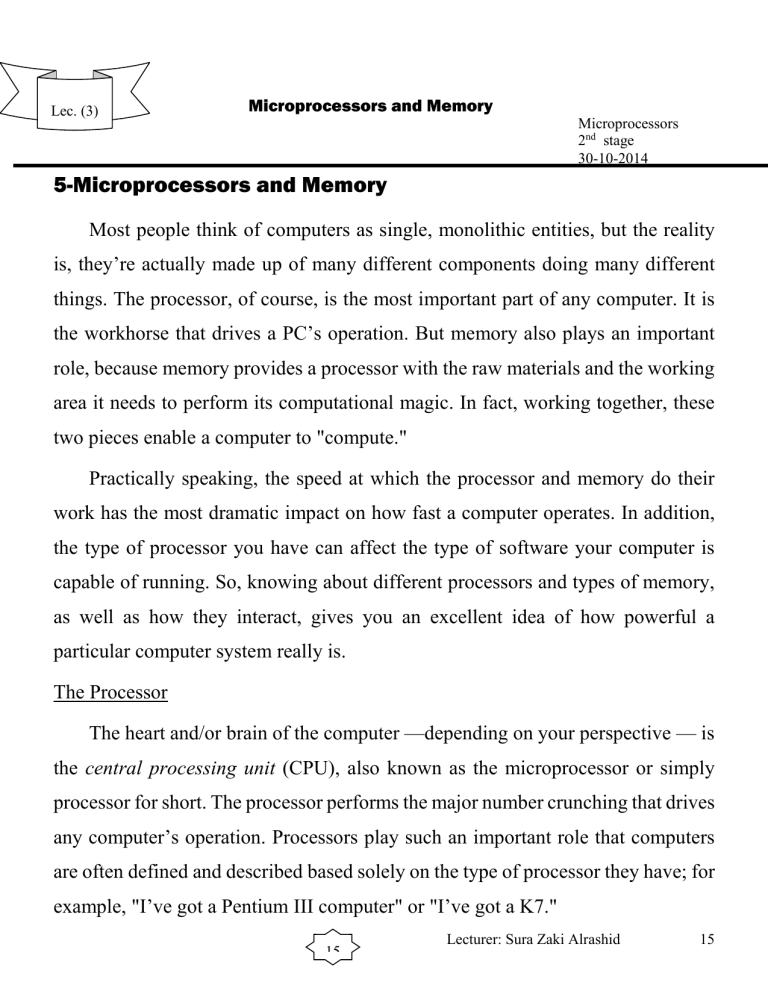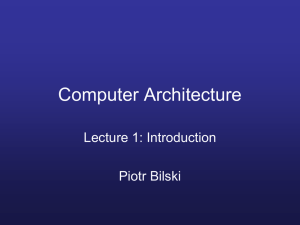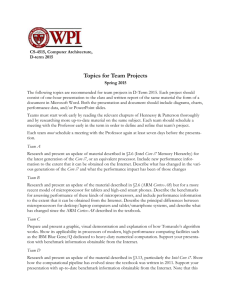high-speed memory

Lec. (3)
Microprocessors and Memory
5-Microprocessors and Memory
Microprocessors
2 nd
stage
30-10-2014
Most people think of computers as single, monolithic entities, but the reality is, they’re actually made up of many different components doing many different things. The processor, of course, is the most important part of any computer. It is the workhorse that drives a PC’s operation. But memory also plays an important role, because memory provides a processor with the raw materials and the working area it needs to perform its computational magic. In fact, working together, these two pieces enable a computer to "compute."
Practically speaking, the speed at which the processor and memory do their work has the most dramatic impact on how fast a computer operates. In addition, the type of processor you have can affect the type of software your computer is capable of running. So, knowing about different processors and types of memory, as well as how they interact, gives you an excellent idea of how powerful a particular computer system really is.
The Processor
The heart and/or brain of the computer —depending on your perspective — is the central processing unit (CPU), also known as the microprocessor or simply processor for short. The processor performs the major number crunching that drives any computer’s operation. Processors play such an important role that computers are often defined and described based solely on the type of processor they have; for example, "I’ve got a Pentium III computer" or "I’ve got a K7."
Lecturer: Sura Zaki Alrashid 15
15
Processors used to be a single chip that connected to different-sized sockets on your computer’s motherboard, which is the main circuit board inside your computer. In fact, some still are, but many newer processors come on a separate circuit board — sometimes called a daughterboard (because of its relationship to the motherboard) — that plugs into a special processor slot on the motherboard.
The most important features to look for in a new processor are:
• The type of processor it is (for example, Pentium III vs. K7)
• The speed at which it operates
• The amount and type of L2 cache (a special type of high-speed memory) it includes
• Any additional processor instructions it supports
• The type of physical connector it uses
How it works
Processors work by performing calculations based on specific instructions that software running on the computer provides. These instructions, which are loaded into the processor when an application runs, tell the processor how to manipulate chunks of data stored in the computer’s memory (RAM). This, in turn, produces the desired result, whether it is adding boldface to text in a letter, changing the color of a background in a scanned digital photo, or what have you. In other words, processors are constantly churning through instructions and data that are loaded into it from the computer’s memory.
Lecturer: Sura Zaki Alrashid 16
16
In addition to working with the main memory, processors also work with a special type of high-speed memory referred to as cache (pronounced cash). In fact, most of the time processors work directly with various types of cache memory and this cache memory, in turn, works with the main memory. Essentially, the cache memory acts as a high-speed buffer in between the processor and main memory, shuffling data into the processor as it needs it, or requests it. As a result, the processor takes advantage of the high-speed cache memory and therefore works faster, which, in turn, makes the computer that the processor drives, operate faster.
Figure 3 illustrates the concept.
Lecturer: Sura Zaki Alrashid 17
17
Figure 3: Cache helps make processors more efficient
Lecturer: Sura Zaki Alrashid
18
18
Cache is a special form of high-speed memory that stores instructions and data the processor has recently used. Thanks to its proximity to the main computing engine inside the processor, and the fact that the processor often needs to reuse those instructions and data, cache keeps the processor busy and speeds up a computer’s performance.
Processor types
Microprocessors come in different types and different speeds. The most popular processors are Intel’s Pentium family, which includes the standard
Pentium, the Pentium with MMX Technology, the Pentium Pro, the Celeron, the
Pentium II, the Pentium II Xeon, and the Pentium III. (MMX, which is sometimes referred to as MultiMedia Extensions, but according to Intel doesn’t really mean anything, is a set of additional processing instructions chips that support MMX can perform.) Other processors you may hear about are the AMD K5, K6, K6-2, K6-3, and K7; the Cyrix 5x86, 6x86, 6x86MX, MediaGX, MII, and MXi; Centaur/IDT’s
Lecturer: Sura Zaki Alrashid 19
19
WinChip, WinChip 2, and WinChip 3; the Rise Technology MP6; the
Motorola/IBM PowerPC; and the Digital Alpha.
Table 1 Common Microprocessors
AMD
Manufacturer
Intel
Cyrix (A division of National Semiconductor)
Centaur/IDT
Rise Technology
K6-3
K7
5x86
6x86
6x86MX
MediaGX
MII
MXi
WinChip
WinChip 2
WinChip 3
MP6
Models
Pentium
Pentium with MMX
Technology
Pentium Pro
Celeron (and Celeron A)
Pentium II
Pentium II Xeon
Pentium III
K5
K6
K6-2
Lecturer: Sura Zaki Alrashid
20
20
IBM/Motorola
Digital/Compaq
Speed
PowerPC 603 and 603e
PowerPC 604 and 604e
PowerPC 750 (aka G3)
G4
Alpha
Many people think processors differ only in speed. They figure a 500 MHz processor from Company A is bound to be faster than a 400 MHz version from
Company B, for example. But this is not always the case.
While a processor’s rated speed is a critical factor in determining how fast it performs calculations, there are other important differences in how various processors work their magic internally. These differences impact how fast various microprocessors perform real-world tasks, such as checking a document for spelling mistakes, recalculating the numbers in a spreadsheet, or removing imperfections from a digital photograph.
For example, many processors can perform several calculations at once; the technology that supports this technique is called pipelinin g. In addition, some jump ahead to perform extra calculations they think the running program will ask for, before the program actually does. This is called speculative executio n, and it is another one of several very complex operations occurring inside today’s processors. In addition, different processors implement these techniques, along with other technology, in different ways, which accounts for many of the differences in overall chip performance, independent of the chip’s rated speed (in
MHz).
Lecturer: Sura Zaki Alrashid 21
21
Another critical factor in overall chip performance is how efficient various processor designs are. Processors are capable of performing continuously, and cranking out results as quickly as they are given problems to work on. Ideally, therefore, you want to feed the processor a steady stream of data so it can keep crunching away at maximum speed. The reality, however, is that — for a number of different reasons — data is not fed into the CPU on a steady, consistent basis. In fact, most processing occurs in fits and starts. This, in turn, slows a computer down.
One of the many ways processor designers attempt to compensate for this is by using the technologies, such as speculative execution. Another even more important way is by adding a special high-speed cache memory into the processor’s or computer’s overall design. In both cases, the goal is to make the
22
Lecturer: Sura Zaki Alrashid 22
processor work as much as possible because this translates directly into faster computer performance.
Figure 4: Feeding the CPU
In an ideal environment, a computer’s processor runs at its maximum rate because it is fed a steady stream of data. In reality, however, various delays that occur throughout a computer system often force a processor to sit idle for brief periods of time, waiting for the next chunk of data to arrive.
15
Lecturer: Sura Zaki Alrashid 22





